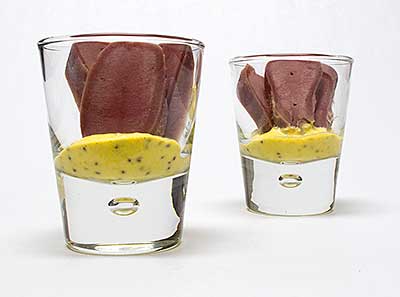July 29, 2013
Amuse-Bouche

langue d’agneau en saumure
(pickled lamb’s tongue)
Every time my mother-in-law walked by my cutting board that winter, the first words out of her mouth were, “Is that tongue?” This wasn’t a polite question. She would spit out the question with a wrinkled nose and as much disgust as she could muster. Any foodstuff that she didn’t recognize, and even a few that she did, would provoke the question.
To say Mom is not an adventuresome eater is definitely an understatement. She wants her food similar to what she’s eaten for most of her 90-plus-year life, a life that didn’t include offal. When I cooked up a pot of pig’s tongues a few years ago while she was temporarily living with my wife and I, she unquestionably considered the concept that I was trying to poison her.
This would not have been a problem with my own mother. She regularly served the family beef tongue. She would buy it cured from the butcher and simmer it with some vegetables for a few hours. We’d eat it with lots of mustard—initially French’s Yellow Mustard and then Gulden’s Spicy Brown Mustard—for dinner. The leftover portion was thinly sliced and put into sandwiches along with mustard, Best Foods Mayonnaise, and slices of dill pickle. The thought of these sandwiches still brings a smile to my taste buds.
When I started frequenting Chinese markets, I often saw packages of pig’s tongues along with the occasional beef tongue although I never found a recipe for them. Then when I started cooking French dishes, veal and lamb’s tongues made their way onto my dinner table. Now, whether the cooked tongues are to be served very simple, as my mother did, or in some elaborate preparation, I always start by brining the tongues.
I use a simple 5% salt and 2% sugar brine with sodium nitrite. I use the brine estimator on my website or on my phone to determine the quantities for the current circumstances. Each tongue is injected with the brine and then submerged in it. Depending on my mood, I may add a few garlic cloves, mustard seeds, a bay leaf, and or some peppercorns to the brining container, but I’m not certain if these additions really affect the final result that much. I have a piece of perforated sheet metal that I use to keep the tongues submerged in the brine. Before I had that, I used a plate. The container goes into the refrigerator for three to five days, depending on my schedule. I try to remember to give the brine and its contents a stir each morning.
Once the brining is complete, I rinse the tongue or tongues under cold water and place it or them in a saucepan with more cold water. Once again, sometimes I add some aromatics, and sometimes I don’t. I cover the meat with an otoshi buta (落とし蓋), a Japanese, wooden drop lid, to keep them under the surface of the liquid. If you don’t have one of these, use a circle of parchment paper. Once the liquid comes to a simmer, I regulate the power knob on my stove to keep it at a simmer, and cover the pot with its lid.
For the first hour, I don’t look into the pot unless I suspect the liquid is not simmering. I start checking the tongue or tongues every half hour or so. I use a long meat fork to pierce the meat from the side. When the fork goes in easily, the meat is done.
I drain the tongue or tongues and set them on a plate. As soon as they are barely cool enough to handle, I use a small knife to peel the skin from the tongues. I usually start by holding the meat with the fork, and as they cool, move to just using my hands and the small knife.
A little while ago, one of my meat purveyors was offering frozen lamb tongues for $4.50 per pound. I ordered ten tongues, which came to a little over two pounds. When I knew I’d have the time to work with them, I defrosted them, brined them for five days, and cooked them up. Once they were peeled, I vacuum-packed them in individual bags and sent them back to the freezer.
When it came time to serve a tongue as an amuse-bouche, I defrosted one. With a little care, one tongue is enough for four, three-slice portions. I made a little sauce by combining some mayonnaise with a large spoonful of whole-seed mustard. The color was a little light, so I doctored this with some ground turmeric, the stuff that makes French’s mustard so yellow. I spooned a little of the sauce into individual serving glasses, and arranged three slices of lamb’s tongue in each glass. I think my mother would approve (even if it makes my mother-in-law would gag).
© 2013 Peter Hertzmann. All rights reserved.
